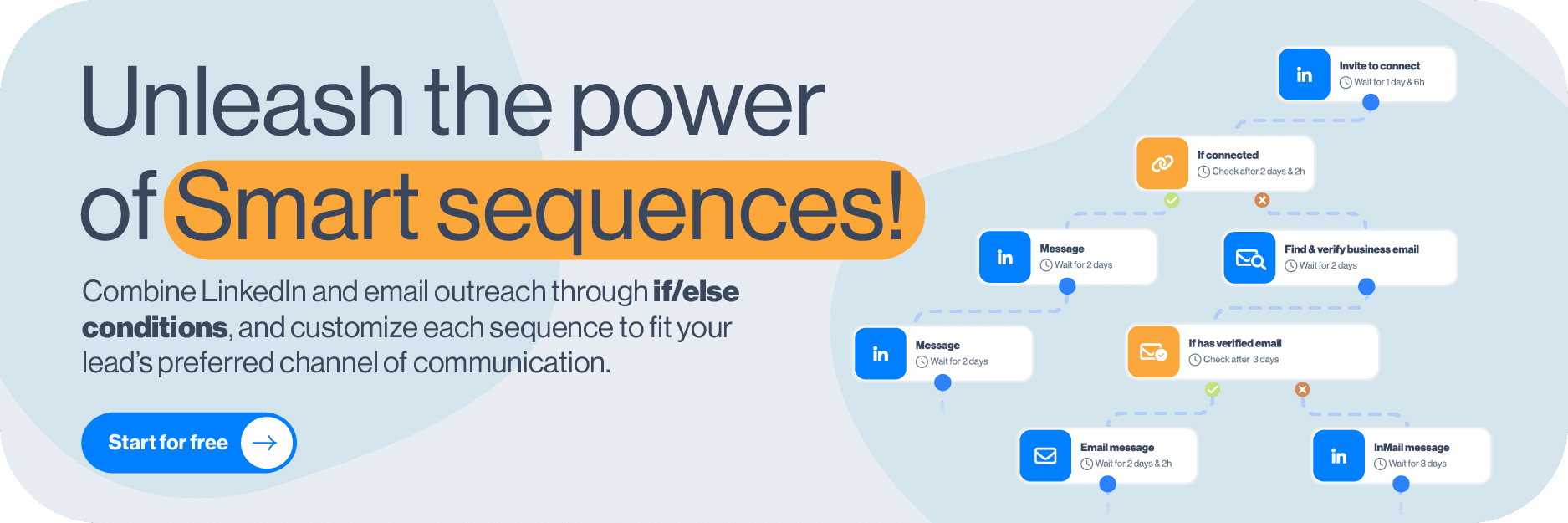Everyone is talking about the Social Selling Index and with good reason. LinkedIn SSI score came into our lives to explain and answer our questions like why my posts have fewer impressions, what I am doing wrong in my outreach, and how my LinkedIn profile can get more integrity in the eyes of the algorithm. Moreover, social selling leaders have 45% more sales opportunities than the ones with a lower LinkedIn SSI score.
That said, if you haven’t already, it’s best to jump into this story and boost your LinkedIn SSI score immediately. However, if you don’t know where to start or what to improve first, don’t despair. We are here to give you tips and pointers from our first-hand experience on improving your LinkedIn SSI score and making this platform work to your advantage.
What is the LinkedIn SSI score?
Social Selling Index is LinkedIn’s measurement of how effective you and your profile are at building your brand. In other words, finding the right people, engaging with insights, and establishing relationships.
Users with a higher LinkedIn SSI score are better positioned to become thought leaders, do LinkedIn lead generation and therefore more likely to succeed in closing the deal. This is LinkedIn’s way of awarding those with high social selling skills.
Where to find LinkedIn SSI score?
SSI is available to everyone, whether using a free or paid LinkedIn account. (If you are not sure where to find it, copy and paste this 👉 www.linkedin.com/sales/ssi in your browser’s search engine. Go ahead and check it. This is your first step towards knowing what you are doing right and what needs a little extra push.
This is what you can expect.
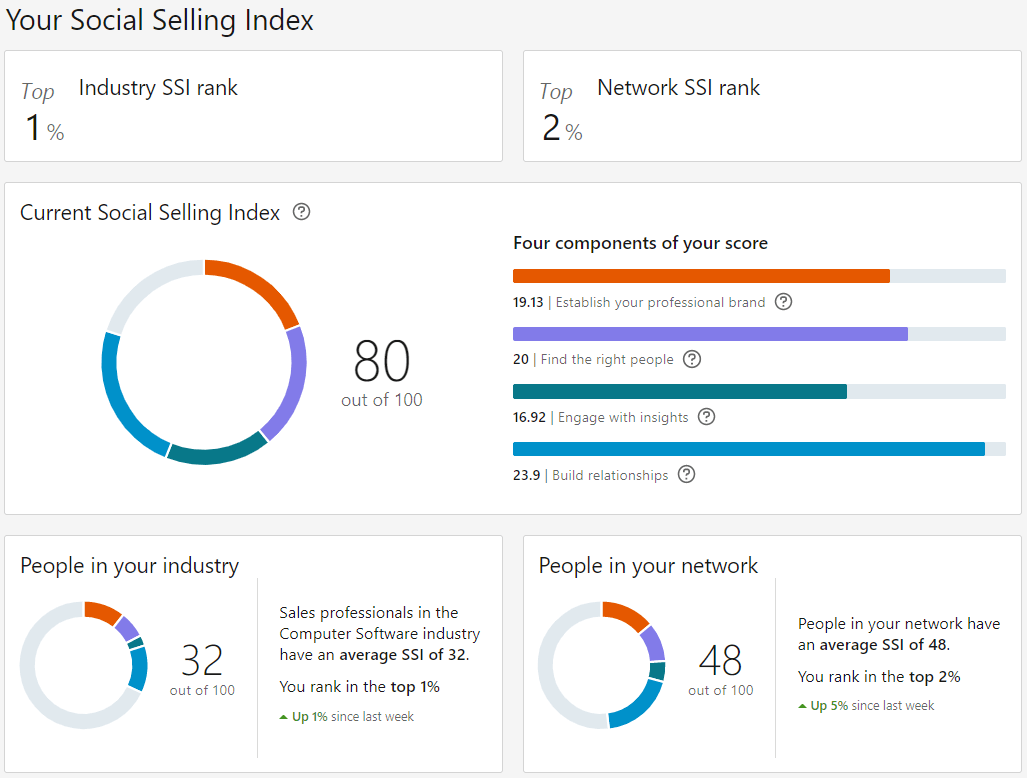
Founded on the above four sections, LinkedIn SSI score shows your success as a salesperson and how effectively you are using the platform.
Each of the segments can grow up to 25 points, with the total score anywhere between 0 and 100. This implies that all four sections are equally valued when measuring your Social Selling Index on LinkedIn.
Tips to increase LinkedIn SSI score
Tip #1: Complete your LinkedIn profile
If you want to boost your personal brand and Social Selling Index, you need to first complete your LinkedIn profile.
Yes, your personal brand starts with a neat and complete LinkedIn profile. The way you communicate with your leads, the way you nurture them, the type of content you post, they all add up. But first and foremost, your profile.
It’s just like in the real world. It takes only a few seconds for someone to form the first impression. And they get attracted or rejected by your looks, not your brains. Sorry, it’s just the way it works.
That said, there are many steps that you can follow to improve the Social Selling Index pillar #1 “Establish your professional brand”. Here is what we did and saw an immediate increase in SSI:
- Upload a professional profile picture that gives the impression of you being a reliable, yet approachable expert in the field.
- Write a catchy LinkedIn headline that sums up what your career is all about.
- Dedicate time to a summary that will make your profile stand out and grab the visitors’ attention.
- Fill out your professional achievements, but don’t overwhelm us. It’s like sending a CV to a recruiter. Only career highlights, please.
- List your fortes.
- Ask for recommendations (from people you worked and had a close bond with).
- Endorse others and others will endorse you. The law of reciprocity rocks.
While striving to fully complete your LinkedIn profile, always have in mind the keywords you would like to be connected with and searched by. Just like you are optimizing your content to show up on Google, you are optimizing yourself to show up in your leads’ search engines.
If you’re still unsure how to set up your entire profile, check out our masterclass. 👇
Tip #2 Find the right people
Speaking of search engines, who is showing up in yours?
As mentioned above, LinkedIn was created to suit business needs. Not personal. Read that again.
Don’t invite people to connect because you like their looks. There are other platforms designed for that.
For you to improve the LinkedIn SSI score pillar #2 “Find the right people”, focus on expanding your network according to the following parameters:
- People you already know in person.
- Users that are from the same industry, are industry thought-leaders, or share an interest in the same industry as you.
- LinkedIn members from adjacent industries.
- Audiences that you think (or even better: you researched) would be interested in your product or service.
Fortunately for all of us, LinkedIn has developed plans, each of them with different perks, depending on what you’re expecting from the platform.
LinkedIn Premium Business, for example, has the same filtering options as LinkedIn basic. However, it does give you unlimited profile search and views, together with 15 Paid and 800 free monthly LinkedIn InMail credits.
On the other hand, Sales Navigator, designed in particular for salespeople, has numerous other options that will make your life easier while searching for that perfect lead. Aside from Sales Navigator advanced filters, it has Lead Lists, Saved Searches, and 20 Paid and 800 free monthly InMail credits.
You can improve the quality of your network and leads by:
- Checking out LinkedIn groups of your interest.
- Reaching out to people attending a certain LinkedIn event.
- Using the Boolean Search to narrow down your audience with more precision.
Tip #3 Engage with insights
Don’t just stand there looking good. Say something. Post on LinkedIn and share your vision with the community. Don’t be afraid to speak up, as the world is full of people thinking differently. Luckily for you, there is plenty of fish in the sea and you will for sure find like-minded users. If that’s what’s worrying you.
For the LinkedIn algorithm to like you and for your Social Selling Index pillar #3 “Engage with insights” to grow, you need to:
- Post engaging and valuable content.
- React and comment on other people’s posts.
- Reshare what you find worthy of resharing.
LinkedIn SSI score is not the only one benefiting from your engagement with insights.
LinkedIn pushes people who give value to the platform by sharing their insights, encouraging constructive criticism, and starting meaningful conversations. These users come up in the search results more often and get more exposure in comparison to inactive users.
That said, make every post count. From our experience, here is what made a difference:
- Providing value,
- And offer a solution to a pain point our network is struggling with.
By engaging with insights, you are telling people who you are and what you stand for. Consequently, you will start being surrounded by like-minded people.
A LinkedIn post can be an excellent source of leads. People who react and comment on a certain topic from your or your target industry are apparently interested in the subject. And are all gathered at one place. Whether picking them manually or scraping all of them by using a Sales Solutions, such as Skylead, making a reference to a certain post is a serious game-changer when it comes to acceptance rates.
Tip #4 Expand network and create relationships
You can have 500+ connections and not stand for a particularly “engaging” member of the LinkedIn community.
If you just had a LinkedIn profile long enough and behaved professionally you are likely to have gathered quite a lot of connections. There you go. But that doesn’t help the LinkedIn algorithm nor it grows your LinkedIn SSI score.
For you to improve pillar #4 “Establish relationships”, do the following:
- Approach other users with a valid reason, be genuinely curious about their career path, ask business-related questions, be ready to reciprocate, and know when to stop (read: don’t spam them). You can use the following LinkedIn connection message template:
Hey {{firstName}},
I loved your {{topic}} post and followed every advice. So far, I have achieved {{achievedResult}}. Thank you so much! I would love to connect and exchange some experiences!
- Comment on other people’s posts or on the comment someone else left. The only way to provide value and show integrity is to give your honest opinion instead of repeating what others said.
- Introduce your connections. If you see that someone works in the same or adjacent industry, or they might benefit from each other, speak up. Not only will your connections appreciate it but they are more likely to return the favor.
- Be responsive. Answer to messages, Invites to Connect, and post comments in a timely (and respectful) manner.
Briefly, you cannot go wrong with making a pleasant social interaction. In addition, what we found worked like magic was incorporating personalized images & GIFs in the outreach. It even increased our response rate to 63%.
Tip #5 Analyze LinkedIn SSI score and improve
Once you start improving your SSI, the job is not done. You need to keep track of your Social Selling Index score, analyze it and see what area you need to improve. From our experience, experimenting with different social selling strategies and monitoring your SSI changes usually does the trick.
Frequently asked questions
How frequently does LinkedIn update the SSI score, and can changes in my activities impact my score immediately?
LinkedIn updates the Social Selling Index (SSI) score daily, reflecting changes in user activities almost in real time. Engaging consistently in recommended activities—like making connections, sharing content, and interacting on the platform—can positively impact your score, demonstrating the dynamic nature of SSI.
Are there any known limitations or criticisms of the LinkedIn SSI score as a metric for evaluating social selling effectiveness?
The LinkedIn SSI score, while useful, is not without criticisms. Some argue it may not fully capture the quality of social selling efforts or the depth of relationships built. It's a quantitative metric that might overlook the qualitative aspects of networking and sales effectiveness.
How can companies or teams collectively improve their LinkedIn SSI scores, and does LinkedIn offer insights or tools for group performance enhancement?
Companies can improve their collective LinkedIn SSI scores by encouraging consistent, strategic activity on the platform, including content sharing, engaging with connections, and endorsing skills. LinkedIn does offer analytics and insights for company pages, which can guide teams in enhancing their overall social selling performance.
To sum up
In real life, you make sure you look professional, your network at events, you are kind and genuinely interested in other people, and you stand behind your values and opinions. Hopefully.
That’s LinkedIn in a nutshell. Just online.
If finding the right people and nurturing relationships is something you would like to take to another level, then start a 7-day Free Trial and see how Skylead can save you 11+ hours a day while generating 10 times more leads.
You chose your path and decided to walk towards Social Selling, a valley of flourishing prospecting fields, meaningful connections, and better conversion opportunities. Now we welcome you to the camp - The Ultimate Guide Part 2, where we will be discussing how to create a tailor-made Sales Strategy for your business.
If you haven’t checked out Part 1 yet, be sure to do so here, where we’ve covered:
- What is social selling
- How to measure social selling success
- 10 tips to boost your sales using social selling
Let’s jump to the sequel of our shared storyline and prepare you for the mountain climb.
Benefits of Social Selling
Firstly, let's distinguish why we are all doing this. Social selling is the most effective sales strategy in recent years. Thus, there are many statistics to prove how vast its potential can be:
76% of buyers are ready to have a social media conversation with potential providers.
Social sellers are 51% more likely to achieve sales quotas.
39% of B2B professionals said social selling reduced the amount of time they had to spend researching potential leads.
84% of C-Level executives use social media to make purchasing choices.
To name a few. So what does this mean, and how can your company benefit from it? Well…
1. Social Selling increases brand visibility.
When a sales team shares content and optimizes their social profiles, their networks grow and engage even more. Besides, these actions are free and organic, meaning you do not need to PPC the hell out of them.
2. Attracts more high-quality leads.
As brand visibility improves, so shall the quality of leads. When you have a team of social sellers armed with good quality content, they are educating their network. So, let's take LinkedIn as an example. Firstly, people on this social network are far more interested in education from their field of expertise. Secondly, the more you post valuable and specific content, the more interest you will trigger, and your niche network will grow, aka you will have the opportunity to reach more qualified leads.
3. Improves website traffic.
The more you share content from your company’s website, the more people will click on the link. On the other side, they will also search for more information on the web about your company.
4. Gaining respect as an individual and the company.
If you show you know what you are talking about and constantly offer value to your network, you will gain their respect. In addition, prospects aren’t easily swayed with any content. You need to provide them with what they do not know - constantly. The more you do, the more respect you will have “on the streets”. Consequently, more people will trust you.
5. Building relationships and gaining trust.
Would you rather talk to a real person or a logo? Of course, the real person. That is why social selling works as you get the chance to build relationships with people. We as a human race wish to feel the connection with the people first and foremost. That is why, apart from posting, you should focus on mingling and chatting with other people. The good-quality relationships you have, the more people will trust you, and that is the true benefit of it all. Do not forget to be honest, genuine, and authentic in the process, otherwise, it will not work.
6. Skyrockets conversion.
Due to gaining respect and building relationships, social selling is also a fantastic way to increase the number of meetings per month - meaning more chances to close the deal and more income to the company.
How to create a sales strategy for Social Selling
A sales strategy is a documented plan with activities and metrics for the sales team to follow and enables them to generate income for the company more efficiently. In other words, if you wish to do social selling, you cannot be sloppy - you must be detailed and organized as your main goal is to convert prospects into customers. In short, here are the steps to tailor-make your social selling strategy.
1# Determine which social media platforms are right for you
Most companies use different social media platforms to raise awareness and their presence. When it comes to social selling, you need to do the same. It might be overwhelming, but know this - you do not have to do everything on every platform possible, as you might do with your company’s presence. Think about what platform your prospects use the most and start from there. Once you establish your presence, you can use other platforms to connect with the prospects. For instance, here is what social media networks proved to be the most effective, according to DataBox.
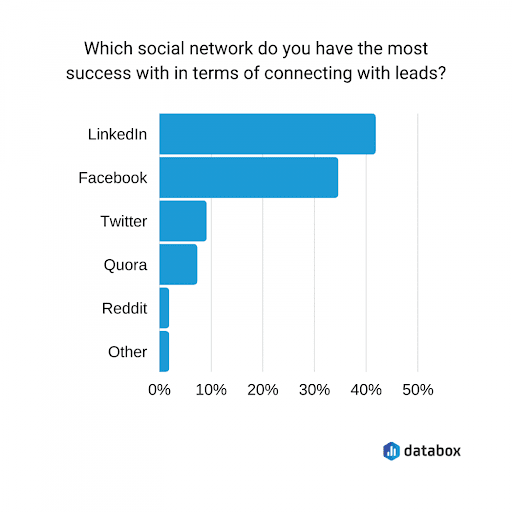
2# Determine your goals and metrics
Social selling doesn't work unless you set goals. Without clear goals and metrics (which we mentioned in Part 1 of the Ultimate Guide), your random acts of social selling will produce uneven results. Hence, to prevent this and prepare a field for the most accurate social selling describe goals using specific words and KPIs.
Social Selling goal examples:
| Goal | KPI Metrics |
| Increase revenue by 20% | - Number of conversions, CLTV |
| Expand network by 350 connections | - Number of invitations sent; Number of connections accepted |
| Nurturing existing customers | - Number of conversations with existing customers |
| Build closer relationships with leads | - Number of warmed-up leads |
| Improve brand awareness by improving website traffic | - Number of webpages visits (UTM them when posting it) |
3# Determine the right ICP
We already mentioned in Part one the importance of the right ideal customer profile. So, be selective of who you interact with. In other words, you cannot expect that just everyone will buy your product or service. When prospecting on LinkedIn, find your niche ideal customer profile and build a relationship with them.
On this mission, you will find out that many tools can help you find who to reach out to.
4# Determine tools to support your sales strategy
Many tools can help out your social selling activities. Some might save you time when you do outreach, such as Skylead, some will help you filter your niche ICP like LinkedIn Sales Navigator, or you simply need to keep all your prospects organized, such as Pipedrive.
5# Determine your unique content strategy and product key benefits
To keep things clean, organized, and as simple as possible, you can create a separate document to join your sales strategy - a Content Strategy. For example, this can be a document that contains:
- Type of content you will be posting
- Posting frequency by days
- Content format
- Content distribution groups or channels
In addition, be careful about the type of content you post, as according to Social Spout, 46% of people may unfollow you if your content is too promotional.
6# Determine Social Selling activities
There are only a handful of social selling main activities you need to perform. You can decide which ones you will use, but you must know that this sales strategy works best if you combine them.
Post
Post your original, educational content, and do it frequently. Consequently, prospects will love it and follow you more.
Share
Sharing other people’s content for a change will eliminate the potential prospect’s perception that you’re self-centered.
Reactions
This is a useful social selling activity for the moments when you are short on time or if you do not have anything to contribute. It shows that you are following the prospect even though you are not engaging more actively.
Comment
Your comment must not be just a sales pitch. Instead, offer your educational 2-cents on the topic in discussion, and link your content or website page ONLY if it can be applied. In addition, comments are a nifty indicator of your genuine interest, as it shows that you are not solely the “distributor” of your own content, but rather a social being. Speaking of nifty - comments are also free publicity on other people’s posts.
Message
Engage with the prospect on a more personal level with DMs. Example:
Hey Bethany,
I’ve just noticed you reached your 2nd anniversary at SaleChart. Just wanted to congratulate you on that. How are things going at SaleChart?
Connection request or a Follow
Social experts say that it is best to wait to make a connection with someone until you’ve had an appropriate reason to. In order to create this “reason” you need to go personal. Therefore, reference their blog post, the content they shared, or mutual connection.
Example of the LinkedIn connection request that will stand out:
Hi Jessie,
Your comment about a couple of sales techniques on Michael's post was quite insightful. So I wanted to add you as my connection. If you are interested, I would like to discuss it further.
Once you determine the activities, you need to keep in mind that they should always be honest, relevant, and hyper-personalized.
7# Determine sales communication funnel
When you create a sales strategy, every activity has to belong to a certain part of the sales funnel. This applies to social selling, as well.
In other words, you need to establish a valid sales communication funnel to know how to engage and warm up the leads, apart from engaging with their content. As people are naturally different and there is no one-size-fits-all when it comes to social selling, we cannot give you the precise sales communication funnel. However, what we can do is to provide you with a basis to start with.
| Stage | Communication type |
| First contact | - Research, - Introduction |
| Interaction (Warm-up) | - Commenting - Liking - Sharing - Experience exchange |
| Interest | - Value 1 - Value 2 |
| Question | - Listening to customers pain points, how they handle the situation |
| Discussion | - Tailor-Made Value 1 - Tailor-Made Value 2 - Educational material |
| Conversion | - Ask for review or referral |
| Nurture | - Communication about product effects - Providing help |
8# Finishing up sales strategy: Activity checklist
Phew! That was a lot, wasn’t it? we’re almost done. Now that you’ve determined this sales strategy, create an activity checklist you need to do daily. Social selling can take a lot of time during the day, especially since sales reps already have a lot on their plate. Trust us because this sheet will help any salesperson organize daily activities and save a lot of time.
Social selling activities will depend on previous steps defined. Since this is the Ultimate Guide, here is an ultimate checklist, which you can use for any platform.
- Firstly, post a content
- Secondly, share relevant content
- Like or comment your prospect’s content
- Take a look at who viewed your profile (if available)
- Send a connection requests to those who did and personalize your approach if they are ICP
- Check out who interacted with your content. Additionally, interact with them
- If people who interacted with your content are not in your network, connect with them
- Review social media notifications for any birthdays, job change etc and act accordingly
- Add new leads to your CRM
- Check on your leads status in CRM and interact with them on social media
- Respond to any messages
- Initiate casual conversation with the leads
- Initiate the connections
- Engage in existing groups
- Find new groups and join
- Lastly, attend events
Once you start doing social selling, you must constantly provide valuable contributions (unless you are on vacation :). Uneven or infrequent social selling can backfire. Every action matters as long as you do not vanish and appear in a month or two.
Sales strategy examples for Social Selling
How does the theory above manifest into reality? Let’s take a look at short-form sales strategy examples.
1# Sales strategy: The one when you become a thought leader
Let’s start with the statistics. According to Hubspot, 92% of buyers are willing to engage with an industry thought leader. For instance, if you learn fast, write faster, and like to mingle, this is a perfect social selling strategy for you.
Thought leaders often use social media to share their experiences. Firstly, their posts are always straight to the point and educational - never promotional. Secondly, they act as a kind of influencer in their niche field.
Scenario: For example, let's say you have B2B software Budgetfy that scans companies' spending and suggests budget optimization.
Goals for 3 months
- Increase revenue by 10% (Metric: Percentage of revenue, profit rate)
- Expand network by 400 connections (Metric: Number of invitations sent, Number of connections accepted)
- Reach 60.000 website visits (Metric: Number of webpages visits)
- Publish a minimum of 36 posts
Social media platform
LinkedIn, Slack groups
ICPs
Chief financial officers, Accountants
Tools to use
- Pipedrive for managing leads
- Sales Navigator for lead search
- Skylead LinkedIn Automation & Cold Email Software to speed up outreach process (outreach campaign, lead discovery, connection requests, view and follow, hyper-personalized cold LinkedIn messaging)
Content strategy and product benefits
- Content format: Text, video, documents, image, link to website, LinkedIn poll
- Content type: content about budget optimization strategy, metrics to follow, business process optimization, finance trends, liquidity management, financial challenges, budget allocation, financial risk management, finance department digitalization…
- Distribution channels: LinkedIn profile, Slack channels, Website communities
- Posting frequency: posting approximately 5 times a week
- Key software benefits: easy control over company’s spending, all invoices in one place, budget optimization recommendations, all-in-one tool, data-driven decisions
Sales communication funnel
| Stage | Communication type |
| First contact | - Discovering the content that prospect shared, events attended, company, - Personalized outreach based on previous findings |
| Interaction (Warm-up) | - Commenting, Liking, Sharing, their content- Asking about the experience with the budgeting |
| Interest | - Budget optimization recommendation- All invoices in one place- Data-driven decisions |
| Question | - Asking Listening to customers pain points, how they handle the budget spendings (Example: they do not focus on finding the most cost-effective purchasing because they do not have time) |
| Discussion | - Offering value in the form of a solution and educational material: Budgetfy can recommend the most cost-effective purchasing options - Offering a call to talk more about their business and provide free trial |
| Conversion | - Communication about product effects and providing help |
| Nurture | - Ask for review or referral |
Social selling activities outside of direct messaging
- Post content
- Share relevant content
- Like or comment your prospect’s content
- Take a look at who viewed your LinkedIn profile
- Send a connection requests to those who did and personalize your approach if they are ICP
- Check out who interacted with your content and interact with them
- If people who interacted with your content are not in your network, connect with them
- Review social media notifications for any birthdays, job change etc and act accordingly
- Add new leads to Pipedrive
- Use LinkedIn Sales Navigator to find prospects
- Create Skylead outreach campaign to extend the network
- Check on your leads status in Pipedrive and send them a message
- Respond to any messages
- Initiate casual conversation with the leads that responded to cold outreach
2# Sales strategy: The one with the questions, groups and events
It is completely alright if you are not a content writer type. What you can do instead is to be active on other levels. Joining groups, asking thought-provoking questions, and starting conversations with the right people is also a nice way to go. What's more, well-thought-out questions in groups, you will attract ideal prospects and start a conversation with them.
Scenario
For example, let's say you have a marketing agency, specialized for generating leads.
Goals for 5 months
- Gain 5 new clients
- Expand network by 1000 connections (Metric: Number of invitations sent, Number of connections accepted)
- Build closer relationships with 100 leads (Metric: Number of warmed-up leads)
Social media platform
LinkedIn, Slack, Facebook, Quora
ICPs
Marketing managers, Chief Marketing Officers, CEOs
Tools to use
- Sales Navigator for lead search
- Skylead LinkedIn Automation & Cold Email Software to speed up outreach process (outreach campaign, lead discovery and generation, connection requests, view and follow, hyper-personalized cold LinkedIn messaging, Whitelabel for clients)
Content strategy and product benefits
- Content format: Text, documents, image
- Content type: questions, polls about latest LinkedIn lead generation strategies, asking how people generate leads in specific industries, what they find to be hardest, leads lists etc.
- Distribution channels: Slack channels, Facebook groups, Website communities
- Posting frequency: Approximately 2 times a week
- Key agency benefits: Extension of the company’s team, easy communication, creativity, data transparency, offering tailor-made, unique lead generation strategies, good quality leads
Sales communication funnel
| Stage | Communication type |
| First contact | - Discovering the content that prospect share - Attend the same events - Personalized outreach based on previous findings |
| Interaction (Warm-up) | - Commenting, Liking, Sharing, their content - Asking about the experience with generating leads |
| Interest | - Data transparency, good quality leads- easy communication - Good quality leads |
| Question | - Asking and listening to prospect’s pain points, how they handle lead generation (Example: they have though time to find good quality leads; listings do not work for them) |
| Discussion | - Offering value. For example, marketing agency owns a unique lead generation strategy creation process. Consequently, they gather good quality leads. - Offering a call to talk more about their business |
| Conversion | - Work in progress |
| Nurture | - Talking about results and asking for a referral |
Social selling activities outside of direct messaging
- Post questions
- Share relevant content
- Like or comment your prospect’s content
- Send LinkedIn connections, follow or add prospects
- Review social media notifications for any birthdays, job change etc and act accordingly
- Organize and document warmed-up leads
- Use LinkedIn Sales Navigator to find prospects
- Create Skylead outreach campaign to outreach the prospects
Summary
As seen from our examples, sales strategy can help you a great deal with your results, especially if we are talking about social selling. However, keep in mind that we’ve shortened our sales strategy examples, and you need to be as detailed as possible.
Repeating is the mother of learning, therefore here is what you need to determine for your social selling strategy:
- Which Social Media Platforms Are Right For You
- Your Goals And Metrics
- The Right ICP
- Tools To Support Your Sales Strategy
- Your Personal Content Strategy And Product Key Benefits
- Social Selling Activities
- Sales Communication Funnel
- Activity Checklist
Remember, social selling takes a lot of time. Once you see the first results, you will fall in love with them.
Wish to share love, help across the internet, and build relationships with prospects? Try out Skylead free for 7 days!
Social Selling or Old Sales Approach?
You are standing at the crossroad in the middle of the field. On the left, there is a sign “The old ways of sales” loosely dangling from the barren tree. A trodden path beneath the sign leads to the campfire in the night. Crows are cawing at you like the alarm, as you approach the tree hole they guard.
Towards the other path hangs a neatly hammered sign saying “Social selling”. Sun shines upon it, and you hear laughter echoing in the valley. You notice something else in the distance: the mountain, tall as the sky itself, and people climbing it.
Which way will you go?
The crossroad choice seems pretty obvious, doesn’t it? Give crows bread crumbs, grab the notebook they were hiding in the tree as your foundation. Let us take your hand as we walk towards the valley and train you for the mountain climb.
What is Social Selling?
Social Selling definition
Let’s start with the basics. Social selling is a lead generation strategy where you should connect with prospects and develop deeper relationships before leading them further down the sales funnel. In general, it can take place online or offline, but due to recent events, it is more of a social media thing now.
A big part of B2B social selling is constantly listening, understanding the prospects’ pain points, educating, and providing tailor-made value. What does this mean for SDRs? Prospects come first - their pain points, worries, and sales reps as company representatives should offer empathy and help in the form of a solution.
Here is how it differs from the old sales ways:

According to LinkedIn, 78% of social sellers outsell their peers who do not use social media.
It is important not to confuse selling on social media with social media marketing and advertising. Social selling means direct and personal interaction with customers via their social media activity to create a sense of credibility and establish a relationship. Social media marketing, on the other hand, means conducting promotional activities using the company's social media accounts and building brand awareness that way.
As social selling is a fairly complex strategy, with a web of possibilities and outcomes, we are creating a two-part blog series so you can easily master your social selling skill to boost sales. Let’s first dive deep into how you can measure the effectiveness of selling on social media.
How to measure Social Selling success
Before sharing social selling tips, we must emphasize how important it is to track and measure social selling activity. With documenting and tracking, you will know where you succeeded or what needs adjusting to improve selling on social media. Here are the top 8 social selling metrics which will help you out.
#1 Social Selling metric: SSI
As one of the most popular selling on social media metrics, LinkedIn’s Social Selling Index (SSI) proved to be a great indicator of your social selling status on LinkedIn.
LinkedIn found a way to measure how effective your presence on this platform is by building your brand, connecting with the right people, engaging, and establishing relationships.
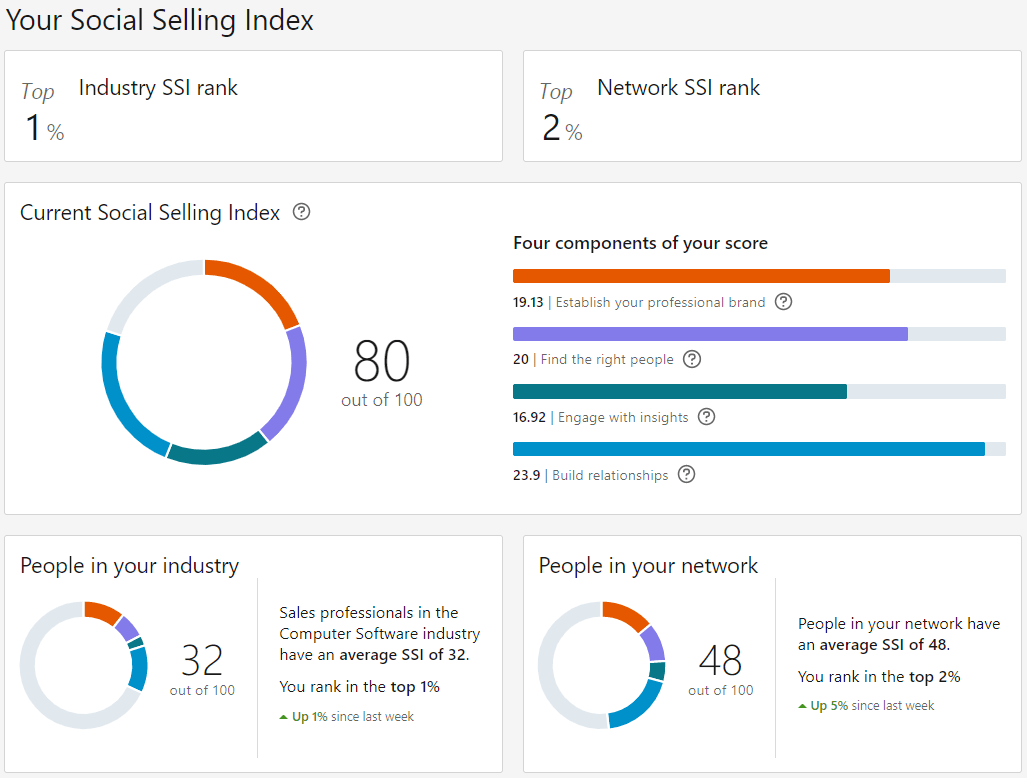
The Social Selling Index is free and available anytime, and it is updated daily. If you wish to see your Social Selling Index, click here.
In general, SSI provides insight into where you currently stand within your network and industry. If you wish to check your Social Selling Index out and improve it, head over to our blog post on how you can improve your LinkedIn SSI Score, and we will tell you all about it.
LinkedIn’s Social Selling Index is not the ultimate metric for social selling as a whole, but it does provide an excellent insight to start with and measure the success on LinkedIn. As LinkedIn is the best social network for B2B sales, it makes sense that you would want to take a step up in your efforts to generate more opportunities there.
Naturally, the social selling index only works on LinkedIn, and you cannot use it across all platforms and activities. What you can measure instead are the metrics below.
#2 Social Selling metric: Message response rate
The goal of social selling has always been quality over quantity and to create a more refined path to conversions. Yet the number of responses stays vital as it mirrors your ability to do the prospecting on LinkedIn, and identify an ideal prospect profile who will respond to you. It's best to track the response rate on each social media account, as it can also indicate your social skill to approach the prospect and which platform works better for you.
How to calculate the message response rate:
(Number of messages responded / Number of Total Messages) x 100
#3 Social Selling Metric: The number of warm leads generated
Since social selling emphasizes building and nurturing relationships, it is only logical to measure this process.

The ability to start a conversation, engage and warm up qualified leads is crucial for the sales funnel and can indicate social selling success. Each warm lead equals an opportunity to present your product or service. To achieve this, you need to have a prior honest and genuine conversation with the prospect to figure out how you can help them. This warm-up needs to be kept track of as they indicate your skills to conduct the beginning steps of selling on social media.
Warmed-up leads are a vital element for generating social selling ROI. Acquiring those types of leads and strengthening the relationship between you and the prospect, will help you during the sales process.
But there is one other benefit. When prospects who you build a strong relationship with become clients, the stronger the relationship is, the longer they will stay as a client, which will generate higher customer lifetime value and lower churn rate.
You can measure warm leads generated by counting the conversation in which you established the relationship, figuring out their pain point, or if they showed initial interest in your company.
#4 Social Selling metric: Social network growth rate
Selling on social media is also about growing your network as much as you can so you can have more opportunities to create warm conversations and develop a valuable relationship with the prospect. That's why social network growth rate is an important metric to track.
The more suitable people you have on your network, the more reach you will have to create opportunities and succeed in selling. You will have a greater chance for your content to be seen by a larger number of the target group members for your business and develop a relationship with them.
The size of the social network plays a massive role in the strategy's effectiveness, but you shouldn’t measure it alone. It should be analyzed along with other metrics, such as engagement rate, to see the complete picture. SDRs who center their efforts around growing their network and not providing value, won’t reach the same results like the ones who do both activities.
How to calculate social network growth rate:
Social Network Growth Rate = (Number of new followers / Number of existing followers) x 100
#5 Social Selling metric: Content engagement rate
The content you share is the foundation of selling on social media. Sharing valuable and relevant, and educational content with your network can position you as an expert in their eyes.
The content with the highest engagement rate is usually the one most valuable to your network. These metrics also show how engaging your audience really is. If the engagement rate is low, you need to get back to the drawing board and think twice about the content you are sharing.
Engagement rate shows whether you are providing the right information to your audience. Type of engagement you need to check out is:
- Likes
- Comments
- Shares
- Saves
How to calculate Engagement Rate:
Engagement Rate (%) = ((Likes+Comments+Shares+Saves) / Total Followers) x 100
#6 Social Selling metric: Number of referrals
One of the main benefits of selling on social media is Word of Mouth, aka referrals. As you build up your network, show your expertise, and engage with leads, you are being positioned as the qualified person to be recommended and referred to. Whatsmore, people will bind your company brand to your name, therefore you will become somewhat of a synonym. You will want to position yourself as a valuable source of information for them to share with others.
The number of referrals is an important metric to track since it shows the exact state of your skill to gain somebody’s trust and provide the right value directly and indirectly to the warm leads connections.
#7 Social Selling metric: Number of booked meetings
The second most important metric to track - the number of demos booked - demonstrates the ability to build a relationship and securely set appointments with the prospect. As leads sometimes tend to vanish before the meeting and never appear, this number should be increased after the meeting finishes.
The higher the number of meetings held, the chances are that the higher number of purchases will be.
#8 Social Selling metric: Average time spent until conversion
Have you ever wondered how much time passes before your warm leads finally convert and pay for the product or service? If not, it’s time that you do.
Analyzing the current time you need to guide prospects through a sales funnel using different social selling activities shows the average time you spent engaging and building relationships across platforms, which ultimately led to conversion. You need to keep track of activities such as the average time:
- Between the first cold approach and response
- To warm up the lead
- To accept a meeting
- The average time to nurture leads
- Overall average time up until the conversion
Being able to see how much time has passed between the activities in total up until the conversion and in combination with other metrics points out shortcomings in your approach and where you can improve your approach. Keep in mind that your approach should be timely and balanced so you can have time to build a relationship, but do not take it too long. Time spent until the conversion is best analyzed with other metrics to show what you are doing wrong.
Experts advise: Social Selling tips to boost sales
Now that we’ve talked about metrics let’s talk about tips and tricks of social selling. Selling on social media channels is not only an activity but much more. It is a strategy to find and convert high targeted leads. There are many tips over the internet, but they are all based on these five basic pillars of social selling:
- Finding the right leads for your business
- Establishing your personal, professional brand
- Engaging with others
- Providing valuable content
- Building a relationship with the prospect.
Let’s check the tips and tricks from experts around the globe and the ones that proved useful here at Skylead.
1. Optimize social media profiles for Social Selling
Before building your network and sharing content, you must first fix your social media profiles. If you ignore this step, you will jeopardize your credibility and most likely waste your efforts on social selling activities.
If we take LinkedIn for example, this is what you need to do:
- Add profile and cover image
- Create a catchy LinkedIn headline for LinkedIn lead generation
- Add a summary
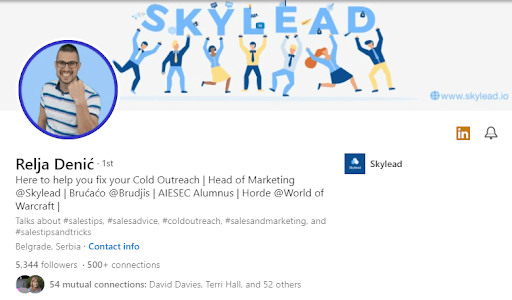
2. Extend your LinkedIn network
As a thought leader, you would want your content to be seen and heard by others, right? That is why the first advice is to extend your social media networks as much as possible and add the right ideal customer profiles at that.
As LinkedIn is the No1 B2B social media network, use it as a base and build other socials around it. You can extend your network by adding second or third connections. The more connections you have, the more you will be able to add other people since the base of the second and third connections will be enriched.
When you send out LinkedIn connection message requests, pay close attention to the note you are sending. Take time to personalize it as this is a crucial step in building the relationship. There are a couple of things you can use here:
- Mention mutual contacts
- Refer to their content piece
- Emphasize the post you both commented
- Mention mutual interests, events you attended, or experiences
Overall, try to form a connection by offering genuine conversation starters.
An example would be:
Hey Stephany,
I’ve noticed that we both attended the “How to define lead generation strategy in 2022” webinar. I saw your awesome profile and wanted to connect and share thoughts and experiences.
You can send connection requests by yourself or you can use a LinkedIn Automation & Cold Email Software such as Skylead to do all the work for you. Here is what a simple, smart sequence for an invite to connect looks like in Skylead:
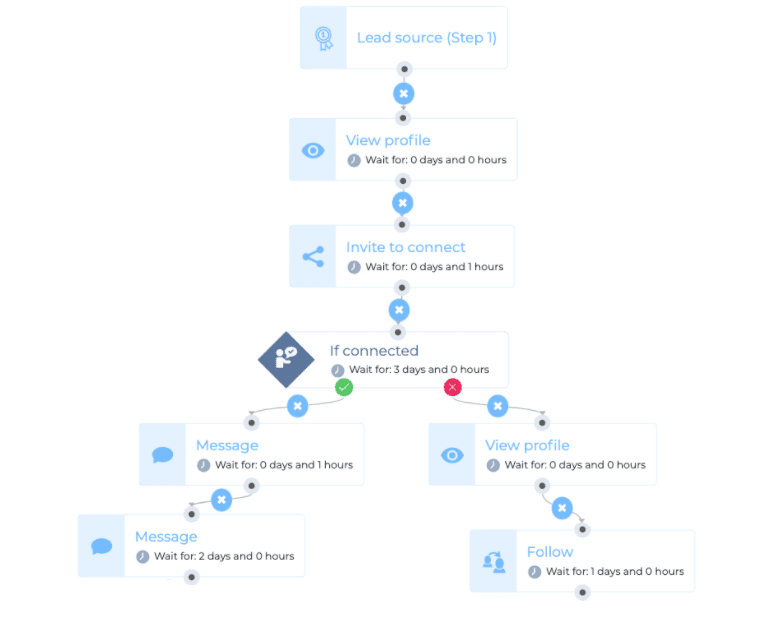
Be sure to check out the DOs and DON’Ts of LinkedIn networking.
3. Build your credibility
Your company has an established brand and credibility on social media. For social selling, you need to do the same. You can build and develop credibility and personal brand with each post, share, comment, or discussion on Social Media.
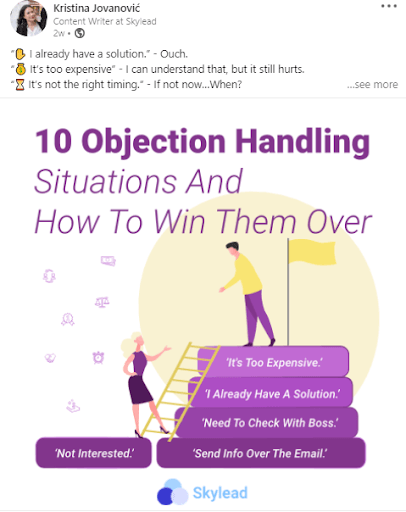
This way, you can showcase your involvement in the industry, demonstrate your expertise and offer value to your prospects. Share your insights, case studies, and success stories. The key here is to be consistent and never to forget to stay active. Always be providing value.
Additional tip: A great conversation starter is to see who liked your post, scrape the data, send them a message and ask for their two cents on the matter.
Example:
Hey John,
I’ve noticed you liked my post on objection handling situations. I was wondering what your experience is in that matter. What objection did you come across the most?
You can also build your credibility by asking for recommendations or endorsements from your network, be it your colleagues or people from the same industry.
4. Participating & engaging in groups
Another way to reach a wider audience is mingling in various social media groups, and the ones outside them, for example Slack or web-based groups, such as GrowthHacker and IndieHackers.
All you need to do is research the groups on every social media channel you use and join them. Once accepted, you can share your posts, chat with other members and find your ICP there.
This relationship that you’ve formed with relevant prospects through groups is an important step for nurturing them as prospects and warming them up. You can start with sharing valuable content, and then introduce them with your product or service, product launches.
On LinkedIn and Facebook, you can search groups easily with keyword search and group filter, whilst Slack groups are a bit harder to find, meaning you would need to Google them. LinkedIn has a vast base of groups, but keep in mind that only some groups on LinkedIn are active, and niche ones at that. Other LinkedIn groups are not active at all.
If you have something to contribute to the group, and you see how you can genuinely interest someone in your product, by all means, do so, but do not copy/paste salesy comments that have no context to the post or prospect’s comment alone. It will only irritate other members. Progress in the conversation in a more natural, push-free way.
5. Researching the prospects
When you handpick a prospect to reach out to, and go all social selling on him, stop and prepare. You need to do the research beforehand.
Social media channels alone are a great way to find out more about someone’s interests, work, and hobbies, so use them. See what they are:
- Reading,
- Sharing,
- What they value most,
- What their thoughts and feelings are.
For example, you can use Twitter to find out about their feelings and trending topics they casually talk about, Facebook for their interest, and LinkedIn for their work. Once you find the necessary information, write it down, and create a personalized outreach based on it, to start building a relationship.
Example:
Hey Mike,
I noticed you openly talked about how patience and long-term planning are crucial for employee retention. Cheers for that, I agree completely. What would you say if I told you that both patience and long-term vision could be easily transferred to employees, so they stay in the company longer?
6. Engage to nurture prospects
If creating content is not your virtue, fear not. If we talk about social selling, one of the main activities, besides publishing your posts, is liking, commenting, and sharing other people’s content.
Pay attention to what others are saying. If you have anything to say, comment and engage with your ICP. Be observant - read, listen, and always keep learning since this will give you greater opportunities to approach your leads, build relationships and nurture them. Your daily social selling activity should be liking, sharing, or commenting on your ICP’s post. When you engage like this, the prospect will see that you are interested in them and be more open to continuing the conversation with you.
7. Nurture existing customers
If we talk about social selling, we simply cannot neglect the existing customers. According to European Business Review, acquiring new customers is five times more expensive than keeping the existing one. After all, existing customers are essential for your customer lifetime value.
The happier and more engaged your existing customers are, the more chances you will get to upsell them and retain them, not to mention the higher the average lifetime value is. Even though they are now in the customer success realm, you as a salesperson cannot forget them because of it, so it is important to engage with them every now and then. Since sales folk have a lot on their plate, they still need to choose where to focus their efforts. That’s where individual customer lifetime value comes into play and analyzing whether the extra action is needed.

8. Keep it real - Create relationships not pushing sales
If we hadn’t emphasized enough so far, let’s do it again - build relationships instead of solely trying to sell. Not a single soul likes being sold something, as everyone ends up feeling manipulated, to say the least. Check it yourself - wouldn’t you feel this way?
Instead, ask what they do, gain full interest in it, make a conversation, and joke here and there, naturally as a human conversation goes when you first meet someone. Be a real person before pitching. Whether you have the best service or a product out there, your job as a sales rep is to make relationships first.
Social selling experts say that even throughout making a relationship you constantly need to provide value to someone to prove your expertise and that is the key to gaining their trust.
After you establish this, listen carefully to what their pain points are and reply to their exact problem. How? With a tailor-made response to present your product.
In addition, if you are not the best fit, be real with yourself, let it be, and move on to find a better ICP.
9. Personalize with GIFs and images
Even though it still isn’t a popularized approach, it always works. Finding the perfect GIF or image and putting your face on it with a custom message will make the prospects loosen up and make them like you even more.
Here is an example of how you can personalize your GIFs and Images in Skylead.

10. Keep it real, but enjoy the process
Social selling is about mingling with people, hearing their stories, learning about new experiences and trends. Remember, people come to social media to relax and escape boredom. They always want to see nice things or interesting videos. So to stay on top and succeed, you need to follow it. This means sharing witty posts or videos from time to time. Find your unique voice in the sea of posts and develop your personal brand.
The key here is to have fun, enjoy interacting with people and build an audience that will remain loyal to your brand.
Summary
Sales really did go far from the old ways, and social selling was a natural evolution step as opposed to a pushy, one-dimension approach. That means things got a bit complicated, but more fun. Here are all the tips formed in one checklist:
1. Optimize social media profiles for Social Selling
2. Extend your LinkedIn network
3. Build your credibility
4. Participating & engaging in groups
5. Researching the prospects
6. Engage to nurture prospects
7. Nurture existing customers
8. Keep it real - Create relationships not pushing sales
9. Personalize with GIFs and images
10. Keep it real, but enjoy the process
When executed together, these tips can improve your sales. You just need to keep in mind that all of the above won’t help you if you do not change your mindset. Empathy is everything and the key to successful social selling. If you do not genuinely care and do not wish to help others, all the battles are lost.
Prepare - the next step is drawing out a social selling strategy, for which we will create another blog post soon.
Wish to personalize your approach and automate a part of your social selling tasks? Check out Skylead and enjoy the ride.
2020 and 2021 were the years that baffled all of us. It was like playing a B2B sales outreach card game.
You are sitting in the darkroom, at the round green table. Across from it, there is your competitor, sweating just as much, trying to keep a straight face. Prize? Leads. A handful of them. Card after card, it appears you have rotten luck. As your coin pile gets smaller, you wonder how you can make a fortune smile at you.
If you missed your opportunity to keep up with the market changes in 2021, here comes another chance. Let’s go through the key tips that can be your aces in a sleeve to stay on top of your B2B Sales outreach game.

How has B2B sales changed over time?
In the past, the B2B sales process was pretty simple. A company would recognize the need, identify a solution through Word of Mouth, and contact one or more providers. After a couple of meetings, the deal would be made.
But in recent years and globalization dramatically entering through the big door and competition getting wider, the providers were left riddled about which approach to use to get a bigger piece of the market cake. A vast number of opportunities opened up: the importance of the company’s content, review websites, social media, or paid ads all flooded the world, which made jobs harder not only for the providers but for clients, as well.
Overwhelmed, clients were getting more suspicious of services’ credibility that they decided to do the research themselves. This ultimately decreased SDR’s opportunity to influence the client's decision.
According to TrustRadius, 78% of B2B buyers are spending equal or more time researching the product or service by themselves.
Outcome and changes
Consequently, the idea of sales and marketing merging and working together became a priority task for the companies and ultimate sales strategy.
Another considerable change that globalization and 2020 events brought to the table is the importance of remote communication itself, thus online meeting software usage, such as Zoom or Google Meet skyrocketed. This made it easier for clients to meet with providers without wasting time.
On the other hand, providers finally got the chance to improve their conversion tracking, but the sales team had the new challenge at hand: improving presentation skills for online time-limited meetings to listen to pain points, showcase personalized benefits and install confidence and expertise in prospects.
So with the new 2022 just getting started, we have yet to see the new B2B sales trends develop. Alas, due to recent changes, some ways to master your sales outreach are here to stay, so let’s get through all of them.
#1 Social selling in B2B sales outreach: The new normal
Assertive selling methods are long out of the picture, thanks to Social Selling. As a new way of the sales strategy, social selling requires narrowing down the niche prospects and developing relationships first, before leading them further down the sales funnel. Developing the relationship will allow you to place the idea into your prospects’ heads and nurture it throughout the buying experience steps.
Today Social selling often takes place via social media channels such as LinkedIn. For example, LinkedIn established a Social Selling Index in which users with higher SSI are better positioned to make new lead connections, and therefore more likely to succeed in closing the deal. Consequently, many SDRs' main mission was to improve their Social Selling Index (LinkedIn SSI score).
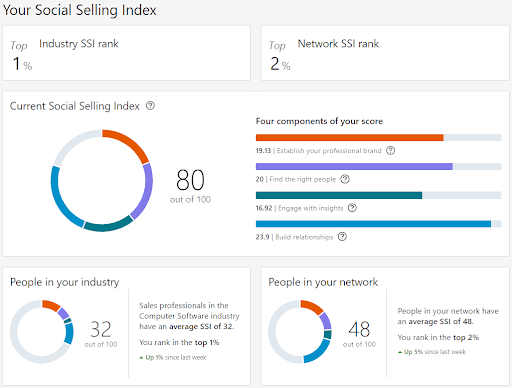
Social selling is a delicate business, and it took sales teams a while to wrap their heads around it. As time passed by, it proved to be effective, so in 2022 social selling is a must for your sales strategy to stay on top.
#2 Understand where your leads came from
It’s 2022, and it is high time to step up your lead organization game. This is where CRM comes in handy. By inserting all the lead information in one place, you will be able to categorize them later on, depending on where they came from. Why? Because the way you engage with them should be different based on where they originated from to personalize their buying experience.
There are no one-size-fits-all categorizations, but the ones that we found useful are:
1. Hand raisers
Hand Raisers are the leads that have reached out to support or schedule a demo via the website. They already know who you are and are halfway to the conversion, which makes your sales approach easier.
2. Custom leads list
Custom leads were found and added to the system manually by an SDR. These leads can be sourced from personal connections on LinkedIn, Sales Navigator Search, or scraped elsewhere online. With this categorization, you can narrow it further by industry, pain point, and so on to further personalize your cold outreach.
3. Educatees
Educatees are the prospects who downloaded some sort of educational material from your website or signed up for a webinar and left contact information for it. Extra attention is needed here as not all of them are your niche leads, so you need to segment them carefully.
4. Lead warmth
One of the simplest ways to categorize your leads is by warmth. Some may be further down the sales funnel than others, and some might not have that much interest as others.
- Cold Lead - Prospects that are right at the beginning of the sales funnel or have little to no interest in engaging with SDRs.
- Warm Lead - Warm leads have expressed some interest in speaking to or needing your company by perhaps contacting customer support via chat or contacting you via Social Media channels. Alas they are not ready for a conversation with an SDR. This lead will typically need a nurturing campaign or direct assistance to move further down the funnel.
- Hot Lead - These leads explicitly said they’re ready to speak to your company or are asking a lot of questions to support this claim.
The good thing about categorization is that you can use one system or combine them to further personalize your approach. All in all, with lead categorization and labeling, you’ll be able to track your KPIs better, understand your LinkedIn lead generation activities, what leads to lead conversion and know what works best and where you should change your approach.
#3 Use video format
As what feels like an everlasting trend, video format continues to amaze with its effectiveness in 2021, not only in marketing but also as a sales strategy. So in 2022, leverage video and step away from long texts to demonstrate the value of your product or service.
According to Wyzowl’s research, 84% of people say they’ve been convinced to buy a product or service by watching a brand’s video.
A brief video can show prospects how the product is used, showcase benefits, short reviews, and set the tone for your sales pitch better than a text format. Incorporating videos into your B2B sales will increase engagement and lead to more sales.
Current trends show that animated explainer videos are a perfect way to demonstrate your product or service, features, and benefits. What’s great about the video format is that it can be used at all stages of the sales funnel.
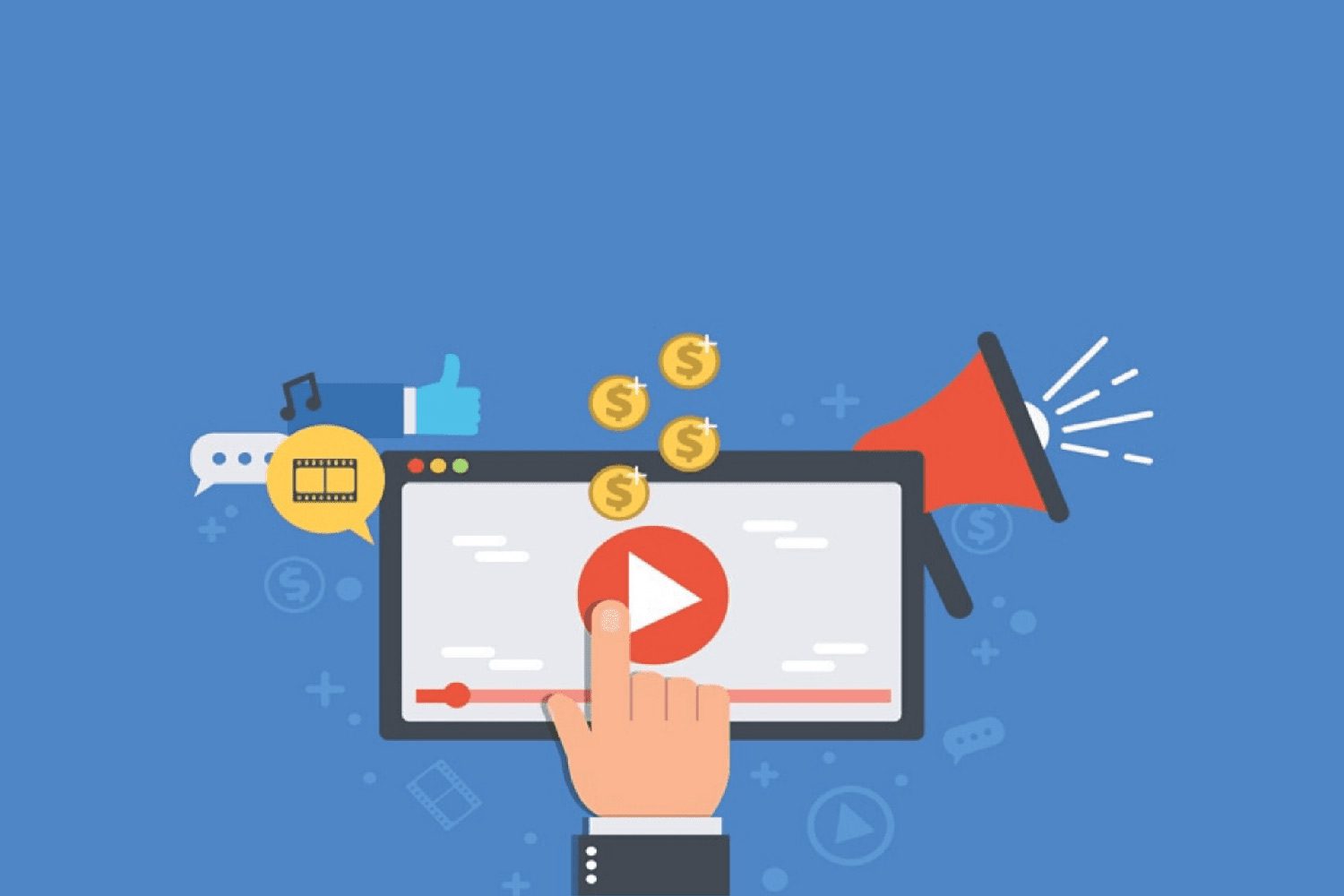
In addition, videos help the B2B prospect to organically conclude that your product suits them best on their own. It builds trust, especially in cold leads, and fosters further education.
#4 Build trust through education
The world has changed. As we mentioned, it's important that you nurture relationships and build trust with your leads, and one of the great ways to do that is through education.
Think about the content the marketing team produces. Mark them for the sales strategy, and use blogs, webinars, whitepapers, or videos to help educate your prospect on what your organization offers.
Remember when we talked about Social Selling? This is one way to do it. If you help to educate them first, guide them towards your solution, and enable them to make their own decisions, they will begin to trust you. Once you gain the trust, you will nurture a relationship to conversion with more ease.
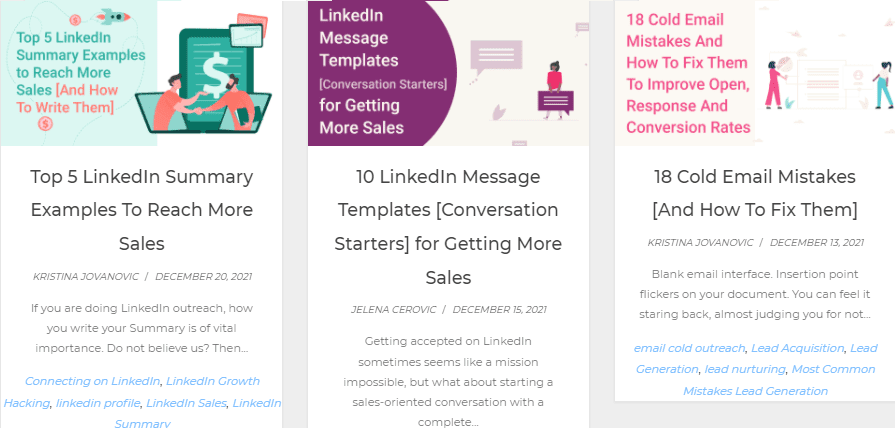
To get the most out of your educational outreach, personalize it further. Instead of sending an entire blog or webinar by itself, take a quote from them, and send them a linked snippet. Trust us, they will be grateful, and the percentage of objections will be by far decreased.
#5 Update the B2B sales outreach process
In recent years, one of the most popular business mantras you could find was to work smarter, not harder. This meant finding alternative ways to simplify the process while getting the best of it and easily scaling it up. This formula was to be applied to the B2B sales process, as well.
But how were people able to do it? What is their Sales strategy? They implemented sales engagement tools.
With the rise of LinkedIn as the most effective way to find B2B leads, along came various tools to help your LinkedIn outreach out, so you can invest the time in more important matters, such as nurturing your leads to conversion. It allows your sales creativity to bloom, delegates and routine tasks to the software itself.
How to master your sales outreach with it?
1. Multichannel approach:
Some sales engagement tools allow you to use a multichannel approach. This means that several channels are working in synchronicity to maximize sales efficiency. Therefore, you can reach your prospects via multiple channels, such as LinkedIn and email. After all, the multichannel approach does bring the best results to the table.
2. Sequences:
If the Multichannel approach is a strategy, then sequences can be the means by which you achieve it. Smart sequences are the future of lead generation, as you can combine different actions in one campaign, define the time delay between them, and send it out to the prospect. The tool will follow the steps and send out outreach you’ve prepared, so you need not worry if some steps slipped between the cracks.
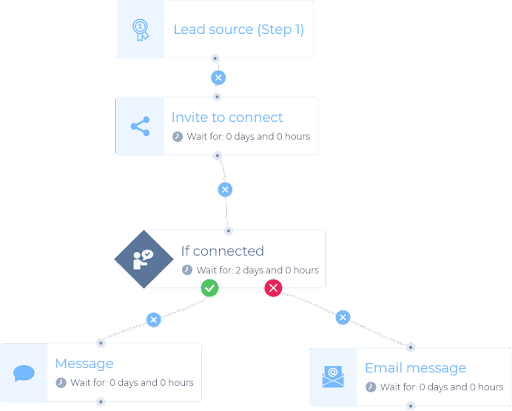
3. Personalization at scale:
Another trend in the B2B sales process became personalization. You need to get as personal as you can with your leads, mentioning their name, interest or company to develop a relationship, show that you care for them, and wish to solve their issue. Naturally, sales engagement tools became a smarter and easier choice to personalize your cold outreach at scale.
To quote Daft Punk with the twist:
“Work it smarter, make it better, do it faster, make it stronger.”
In conclusion
B2B sales outreach is ever-changing, and it always will be. That is why you need to stay on top of trends and best practices to stay in the game.
There are still many paths to follow to master your B2B sales outreach, but the core ones are:
- Update The Sales Process
- Improve Social Selling
- Understand Where Your Leads Came From
- Use Video Format
- Build Trust Through Education
You don’t have to implement every tip that we mentioned. Choose the one, A/B test it, and then apply which one works best for you. Own it, win it!
Let’s win 2022 together! Check out Skylead, a LinkedIn Automation & Cold Email Software that thinks for you and try it out for free.



